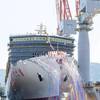The Tampa Bay economy receives more than $7 million a year in savings and direct income from the operation of the Physical Oceanographic Real-Time System (PORTS), according a new NOAA sponsored study. The report details the first study of the navigational aid, which is in operation at 13 major ports across the United States.
Tampa's PORTS system provides accurate real-time oceanographic information tailored to the specific needs of the 6,700 commercial vessels transiting Tampa Bay each year.
"The PORTS system is a good example of how research and observing system development expertise can be applied to support safe, efficient and environmentally sound marine transportation," said retired Navy Vice Admiral Conrad C. Lautenbacher, Jr., Ph.D., undersecretary of commerce for oceans and atmosphere and NOAA administrator.
"Tampa Bay PORTS is an excellent example of NOAA'S creativity and technological expertise," said Richard Wainio, Port director and chief executive officer of the Tampa Port Authority. The Tampa Bay maritime users have realized enhanced navigational safety while transiting the long channels of the harbor. This has resulted in more efficient loading logistics, enhanced vessel traffic management, and better protection of the environment and citizens of the Tampa Bay region. It is especially helpful for both planning and maintaining the flow of maritime commerce, during periods of disturbed weather conditions."
"This study validated what we have been hearing for some time," said Mike Szabados, director of the NOAA Ocean Service Center for Operational Oceanographic Products and Services. "It quantified the benefits as being far greater than the cost of the system and demonstrates that the system provides valuable support for the safe and efficient maritime commerce necessary for a healthy economy. The benefits are not just good, they are impressive."
The most significant change in maritime shipping operations in the bay in the 1990s occurred when Harbor pilots onboard vessels began using portable computers to access PORTS in real-time. During this time, groundings decreased by half. With tankers accounting for 2,200 transits per year, the 50 percent reduction in groundings translates into a conservative estimate of $2.8 million in avoided costs annually. The PORTS system was installed in Tampa in 1990.
The system provides real-time data available to load ships to drafts 12 inches or more above what had been considered the safe guideline. The additional capacity for the phosphate trade alone in Tampa Bay could equal an increased benefit of $1.1 million each year.
Even though hazardous chemical spills in Tampa Bay are rare, at a conservative estimate the additional efficiency and accuracy of applying these data would avoid nearly $1.8 million per year in losses.
PORTS data are used to enhance area weather and coastal marine forecasts, particularly coastal flooding. Tampa Bay is considered one of the most storm surge threatened areas in the country because of its large coastal population and its geography. Applying PORTS® data risk formulas for forecasts in the area gives it an estimated yearly value of $2 million.
Recreational boaters, using better real-time information available through PORTS, may make more excursions, bringing an estimated $946,000 to the economy each year. Fishermen looking for water temperature and tidal data to improve their catch contribute another estimated $150,000 per year in port area income.
The report was authored by Hauke Kite-Powell, Ph.D., of the Woods Hole Oceanographic Institute Marine Policy Center, who designed the method of identifying as well as collecting and quantifying the data. The Tampa study was the first application of the methodology, which NOAA plans to use in evaluation of PORTS systems in Houston and New York in 2006.
PORTS systems also operate in San Francisco Bay; Chesapeake Bay, which serves Delaware, Maryland and Virginia; Narragansett Bay, Rhode Island; Soo Locks, Mich.; Los Angeles/Long Beach, Calif.; Delaware River and Bay; Tacoma, Wash.; Port of Anchorage, Alaska; New Haven, Conn., and the Lower Columbia River, bordering Oregon and Washington.
NOAA, an agency of the U.S. Department of Commerce, is dedicated to enhancing economic security and national safety through the prediction and research of weather and climate-related events and providing environmental stewardship of the nation's coastal and marine resources.
Through the emerging Global Earth Observation System of Systems (GEOSS), NOAA is working with its federal partners and nearly 60 countries to develop a global monitoring network that is as integrated as the planet it observes.
Sponsored Content
MSC Sets a New Standard for Time Off in 2025, Plus Earn a $38,340 Bonus as an Able Seaman!

Featured videos

AI to the Rescue: Zelim’s ZOE to be Installed on Cruise Ship

Xenos Marine Takes Aim at the Gulf Salvage, Decommissioning Markets
Subscribe for
Maritime Reporter E-News
Maritime Reporter E-News is the maritime industry's largest circulation and most authoritative ENews Service, delivered to your Email five times per week










